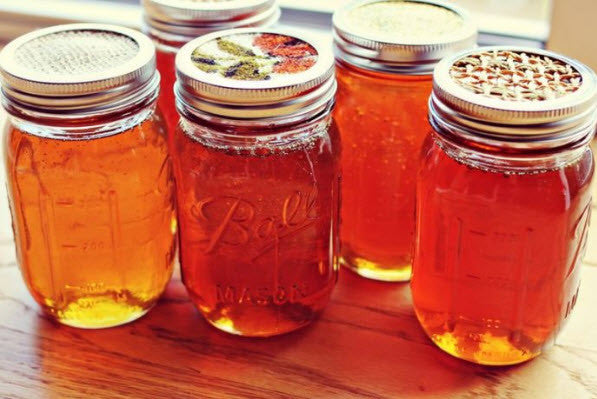
Honey's Not GMO
Share

Pure natural honey is, by definition, a non-GMO food. It’s that simple.
By: Michelle Poulk
This message is supported by the American Beekeeping Federation, American Honey Producers Association, National Honey Packer & Dealers Association, Sioux Honey Association and the Western States Packers & Dealers Association. As a collective group, these organizations represent approximately 95% of the entire United States Honey Industry.
Today’s consumers rely on many sources for information on their diet and food choices. Perhaps the most frequently consulted, but least reliable, source is the internet – where everyone can be an ‘expert’ on their chosen subject. Gluten-free, raw, local, vegetarian and non-GMO are currently among the food topics most often discussed.
Regarding a non-GMO diet, some of the main questions being asked of the honey industry are:
“Is honey free of GMOs?”
Answer: The FDA discourages the use of the term “GMO Free” because all food items may contain trace amounts of GMOs. The European Union, Australia and other countries have established thresholds for their GMO labeling laws. The regulations require all food items which contain more than 0.9% GMOs to declare GMO contents on the labels. Honey is not required to be identified or labeled as a non-GMO food because GMO’s in honey never exceed this threshold. Honey, as most other foods, may not be completely GMO free, but it is a non-GMO food according to the standards established by the European Union, Australia and other countries.
“I am on a non-GMO diet. Can I eat honey?”
Answer: Pure honey can be introduced into a non-GMO diet and not only will you maintain your personal nutritional choices, but you will receive all the wonderful benefits honey has to offer.
“If honey is not Certified as non-GMO, does that mean it may contain GMOs?
Answer: Although some interest groups and organizations appear to complicate the issue, the simple truth is this: honey qualifies as a non-GMO food. It does not require any type of certification in order to be classified as a non-GMO food item. Some companies choose to have their honey certified as “non-GMO” by independent organizations, but in terms of GMO content, honey certified as non-GMO is not superior to any other non-certified pure honey.
“Can trace GMOs be eliminated from honey by monitoring bee forage areas?”
Answer: It is not realistically possible to monitor all honey bee forage areas, or to create a GMO-free forage zone. Even if a GMO-free zone were to be established, bees can travel great distances, and neighboring bees could enter the GMO-free zone and distribute pollen containing GMOs onto non-GMO crops.
To better understand the basics of GMOs, here are the FDA definitions on the subject:
“Genetic modification” is defined as the alteration of the genotype of a plant using any technique, new or traditional. “Modification“ refers to the alteration in the composition of food that results from adding, deleting, or changing hereditary traits, irrespective of the method.
This definition is provided by an independent certification organization:
“GMOs (or “genetically modified organisms”) are living organisms whose genetic material has been artificially manipulated in a laboratory through genetic engineering, or GE. This relatively new science creates unstable combinations of plant, animal, bacterial and viral genes that do not occur in nature or through traditional crossbreeding methods.”
So how are these definitions applicable to Honey?
Honey is a food produced by bees from the nectar of plants. Honey is not a plant and there are no known species of genetically engineered (GE) honey bees. The definitions support honey’s established status as a non-GMO food item.
Here are just a few of the facts about honey as a non-GMO food:
No genetically modified honey bees exist
Honey is made by bees from the nectar of plants
Honey is not a food that has been artificially manipulated in a laboratory
The amount of pollen in honey ranges from about 0.1% to 0.4%
On average, pollen in honey contains about 0.2% protein. GMO markers may be found only in the protein
Any trace of GMO’s in honey, therefore, will fall far below the 0.9% threshold established by countries around the world as requiring GMO labeling
In the US, there are no current national GMO labeling requirements. Moreover, the state of Vermont enacted legislation in 2016, which clearly excludes foods from any GMO labeling requirement when the food is “consisting of or derived entirely from an animal that is itself not produced with genetic engineering, regardless of whether the animal has been fed or injected with any food, drug, or other substance produced with genetic engineering”.
Honey bees, beekeepers and the honey industry are direct contributors to the success of American and world agriculture. In today’s world, the honey industry faces many problems such as hive loss, drought, colony collapse and shrinking forage areas. Fortunately, honey’s position as a pure and natural food is unchallenged.
Produced by bees from the nectar of plants, honey is a non-GMO food, the purest of nature’s sweets.
(The above article by Michelle Poulk appeared in Bee Culture - The Magazine of American Beekeeping on August 23, 2016.)
References:
http://www.nongmoproject.org/learn-more/
http://www.honey.com/images/uploads/general/Australian_2004_Canola_pollen_study.pdf
http://www.ago.vermont.gov/assets/files/PressReleases/Consumer/Final%20Rule%20CP%20121.pdf
